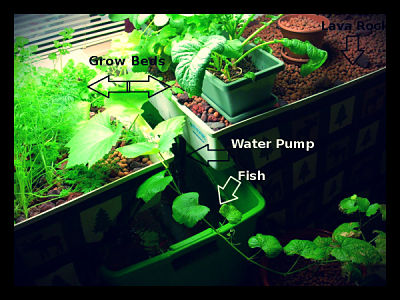3 Ways Aquaponics Encourage Urban Food Sustainability
 Imagine staring out over the observation deck of the Empire State Building and seeing a greenhouse covered Manhattan skyline able to provide fresh fish and produce for all of their buildings’ tenants. Thanks to the technological breakthrough of Aquaponics, urban food sustainability might actually be a reality.
Imagine staring out over the observation deck of the Empire State Building and seeing a greenhouse covered Manhattan skyline able to provide fresh fish and produce for all of their buildings’ tenants. Thanks to the technological breakthrough of Aquaponics, urban food sustainability might actually be a reality.
1. It’s self-contained – Unlike the traditional agricultural method of crop or fish production requiring thousands of acres of land or huge tanks and logistical support, the Aquaponic growth method requires little more than a storage container size of available rooftop space. Additionally, the growth system simply requires daily maintenance, a little electrical power, and labor, enabling an apartment building or home to produce their own organic food and fresh fish supply anywhere in the world. This method has the potential to eliminate the environmental damage of topsoil runoff and over-fishing and promote long term urban food sustainability.
2. It’s affordable – As previously stated, the cost of purchasing the land, equipment, and labor resources necessary for commercial farms is extremely expensive and often prohibitive to nations establishing their own urban food sustainability programs. However, the start-up cost of an Aquaponic system starts at only 3,000 dollars for a beginner package to 7,000 dollars for a package able to significantly impact a family’s annual food costs. Furthermore, the construction of a simple rooftop greenhouse is extremely cheap, and necessary for both environmental protection and the maximum fish and production yield of the Aquaponic system.
3. It provides a source of income – As an added incentive, the market for organic produce and fresh fish is in high demand and given the relatively low start-up costs of the technology and accompanying greenhouse, the Aquaponic system can serve as a viable source of income. Even better, by forming a co-op among buildings tenets for the construction of several Aquaponic greenhouses on a rooftop, the fresh fish and produce can be sold at local farmer’s markets and to fishmongers, generating a passive source of income. Given the ability of the Aquaponic technology to be deployed anywhere in the world, building tenets from Manhattan to Moscow can enjoy the income generated from fresh, year-round fish and products which not only enriches the inhabitants’ wallets but also encourages urban food sustainability.
– Brian Turner
Source: Aquaponics.com
Photo: Aquaponicsfaq
